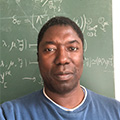Dr Lassina Dembélé
An Ivorian-Canadian mathematician and researcher who has made significant contributions to the field of number theory.
Dr Lassina Dembélé moved to Montreal, Canada to complete his studies and obtained a PhD from McGill University, Canada. He held various research positions at Brandeis University, University of Calgary, Institute for Experimental Mathematics at the University of Duisburg-Essen, Dartmouth College and the University of Luxembourg. He also spent time at the University of Warwick as a Marie-Curie Fellow and an EPSRC Career Acceleration Fellow.
Dembélé's research is focused primarily on the theory of modular forms and their applications to arithmetic geometry, an area that is at the intersection of number theory and geometry. His work has led to the development of new techniques and methods for solving difficult problems in number theory.

There is no denial that certain visible minorities are underrepresented in mathematics. I often hear people say that the best way to fight this issue is to have more role models from those minority groups that lack representation in the mathematical community. I believe that is true.
Dr Lassina Dembélé, quoted from Canadian Mathematical Society's YouTube channel.
In addition to his research, Dembélé is a dedicated teacher and mentor. He has supervised several PhD students and postdoctoral researchers, many of whom have gone on to successful careers in academia and industry. He is also actively involved in outreach programs that aim to promote mathematics education and research in underrepresented groups as well as in Africa.
Overall, Lassina Dembélé is a highly respected mathematician and researcher who has made important contributions to the field of number theory. His work has not only advanced our understanding of fundamental mathematical concepts, but has also inspired and mentored the next generation of mathematicians.
The Department of Mathematics had the honour to have him as a guest in April 2023 for a lecture about inclusion and outreach.
References:
- Canadian Mathematical Society (youtube.com/@canadianmathematicalsociet765)
- King's College London (kcl.ac.uk)